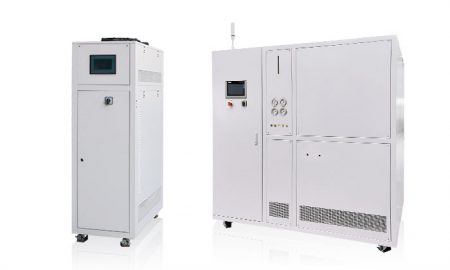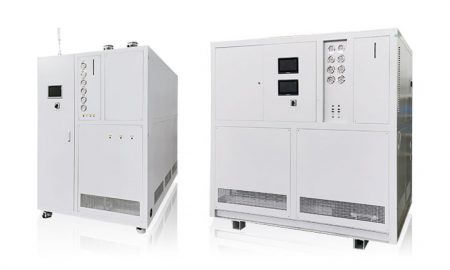Dynamic and Precise Temperature Control Unit for PEM Fuel Cell Stack
Fuel cell technology has begun to be applied in the automotive field in recent years, and our country is also vigorously developing this industry. With the development needs of this emerging industry, battery assembly test benches and supporting special equipment also require supporting research and development. At present, there is a relative lack of temperature control systems for supporting fuel cell testing in China, and there is an urgent need to develop a fuel cell testing temperature control unit suitable for fuel cell temperature testing needs.
The main test purpose of the fuel cell test temperature control unit is to test the starting characteristics of the fuel cell under different ambient temperatures and to verify the battery performance at different temperatures. Since the simulation of ambient temperature is generally implemented in an environmental test chamber, the temperature control unit mainly prepares low-temperature circulating coolant. The circulating coolant enters the cooling channels of the motor, controller, proton exchange unit and other components to achieve different parts of the powertrain. Achieve different flow and test temperature requirements, and verify its performance at low temperature start-up and operation at different temperatures.
The fuel cell test temperature control unit adopts a double-stage cascade vapor compression refrigeration cycle. The temperature of the circulating cooling medium can reach minus 60°C, which can meet the battery cold start test requirements in all regions on the earth. The controller based on the PID algorithm controls the refrigerant flow. , to achieve high-precision temperature control requirements for different channels. It has high-pressure, low-pressure, oil shortage, overload, over-temperature and other safety protections to protect the oil return of the compressor and the safe operation of the equipment.
The fuel cell test temperature control unit realizes the requirements for different flow rates and test temperatures in different parts of the powertrain. It can verify its performance at low temperature start-up and operation at different temperatures. It can also be used in similar lithium battery and motor testing industries.
We provide complete temperature control systems design and manufacturing. From standard models to complete customized products. We specialize in customer service and are dedicated to helping each customer have the optimal temperature control system for their specific need.
Forniamo soluzioni personalizzate non standard. Sono disponibili sia chiller a raffreddamento singolo che unità combinate di raffreddamento e riscaldamento.
E-mail: lilia@lneya.com ID WeChat: +8615251628237 WhatsApp: +86 17851209193


Sistemi di controllo della temperatura e del flusso di calore/raffreddamento
Simulazione della temperatura per il test di qualità del veicolo: test di durata della batteria, banco di prova dell'iniettore/motore del carburante, test dell'airbag, banco di prova dei componenti, ecc.
| Intervallo di temperatura | -25°C ~ +100°C | -40°C ~ +100°C | 0°C ~ +100°C | -40°C ~ +135°C | |||||
| Capacità di raffreddamento | 2,8 ~ 38kW | 1,2 ~ 60kW | 1,8 ~ 60kW | 4 ~ 60kW | |||||
| Nota: qualsiasi intervallo di temperatura da -150℃ a +350℃ e qualsiasi capacità di raffreddamento possono essere personalizzati. | |||||||||
Temperatura / Pressione / Flusso controllabili in modo indipendente
1&2: una macchina per due gruppi di controllo
| Intervallo di temperatura | -40 ~ +100℃ 1&2 | 0 ~ +100℃ 1&2 | |||||||
| Capacità di raffreddamento | 1,8kW*2 ~ 60kW*2 | 1,8kW*2 ~ 60kW*2 | |||||||
| Nota: qualsiasi intervallo di temperatura da -150℃ a +350℃ e qualsiasi capacità di raffreddamento possono essere personalizzati. | |||||||||
La temperatura rimane costante, mentre la pressione e il flusso possono essere controllati in modo indipendente.
1&3: una macchina per tre gruppi di controllo
1&6: una macchina per sei gruppi di controllo
| Intervallo di temperatura | -40 ~ +100℃ 1&2 | -40 ~ +100℃ 1&3 | -40 ~ +100℃ 1&6 | -20 ~ +100℃ 1&6 | 0 ~ +100℃ 1&2 | 0 ~ +100℃ 1&3 | 0 ~ +100℃ 1&6 | ||
| Capacità di raffreddamento | 2,5 ~ 60kW | 4 ~ 60kW | 10 ~ 60kW | 10 ~ 60kW | 7 ~ 60kW | 11 ~ 60kW | 18 ~ 60kW | ||
| Nota: qualsiasi intervallo di temperatura da -150℃ a +350℃ e qualsiasi capacità di raffreddamento possono essere personalizzati. | |||||||||

Refrigeratori d'olio
Simulazione della temperatura per il test di qualità del veicolo: test di durata della batteria, banco di prova dell'iniettore/motore del carburante, test dell'airbag, banco di prova dei componenti, ecc.
| Intervallo di temperatura | 0℃ ~ +160℃ | +5℃ ~ +135℃ | |||||||
| Capacità di raffreddamento | 11 ~ 60kW | 15 ~ 38kW | |||||||
| Nota: qualsiasi intervallo di temperatura da -150℃ a +350℃ e qualsiasi capacità di raffreddamento possono essere personalizzati. | |||||||||

Sistemi di raffreddamento e riscaldamento per pompa elettronica
| Intervallo di temperatura | -40°C ~ +135°C | ||||||||
| Capacità di raffreddamento | fino a 60kW | ||||||||
| Nota: qualsiasi intervallo di temperatura da -150℃ a +350℃ e qualsiasi capacità di raffreddamento possono essere personalizzati. | |||||||||

Camera di prova per batterie ad alta e bassa temperatura
| Intervallo di temperatura | -40℃ ~ +100℃ | -40℃ ~ +100℃ | |||||||
| Capacità di raffreddamento | 1,8 ~ 7,5kW | 4 ~ 15kW | |||||||
| Nota: qualsiasi intervallo di temperatura da -150℃ a +350℃ e qualsiasi capacità di raffreddamento possono essere personalizzati. | |||||||||

Sistemi di raffreddamento o riscaldamento diretto per autoveicoli
| Tipi | Raffreddamento diretto | Raffreddamento e riscaldamento diretti | |||||||
| Capacità di raffreddamento | 5 ~ 10kW | 5 ~ 10kW | |||||||
| Nota: qualsiasi intervallo di temperatura da -150℃ a +350℃ e qualsiasi capacità di raffreddamento possono essere personalizzati. | |||||||||

Raffreddamento a liquido per i sistemi di accumulo di energia a batteria
| Tipi | Per la stazione di conversione | Per la batteria di accumulo dell'energia | Per la stazione di ricarica | ||||||
| Capacità di raffreddamento | 45kW | 5 ~ 8,5kW | 4kW | ||||||
| Nota: qualsiasi intervallo di temperatura da -150℃ a +350℃ e qualsiasi capacità di raffreddamento possono essere personalizzati. | |||||||||
 LNEYA
LNEYA
 简体中文
简体中文


















































































